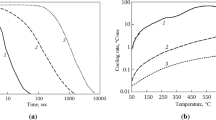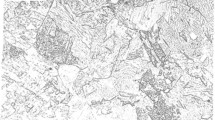Abstract
It has been difficult to judge, in actual practice, the cooling capacity of a quenching medium based on cooling curves recorded from silver test pieces. This is partly because silver has a much greater heat conductivity than steel and partly due to the fact that certain quenching media, such as oil emulsions and polymer quenching media, give rise to cooling curves that are not readily capable of interpretation. A number of such examples illustrating these difficulties are given in the paper.
Even when the cooling curves are recorded from steel test pieces (both austenitic and martensitic), misjudgments do occur, in many instances, because of a lack of understanding of the transformations taking place in the temperature ranges that are inherent in the various stages of the cooling curve.
When steel is being hardened, it is necessary to take into consideration the occurrence of nucleation and growth, which affect the diffusion-dependent transformation products. The realization of this concept is fundamental to the new application of the cooling curves.
From investigations using dilatometer techniques and actual hardening tests, it has been possible to prove that, contrary to current consensus of opinion, a protraction of the vapor-blanket stage in the upper metastable austenite range is beneficial to the hardenability of the steels under investigation. There is no lack of references in the earlier literature testifying to this observation, but they have been ignored since no acceptable explanations were advanced.
If, after hardening, an insufficient amount of martensite results and a large amount is required, it is most essential that there shall be a high cooling rate through those temperature ranges in which the main part of the diffusion-dependent transformations take place. Investigation results that definitely prove this fact will be reported in this article.
The temperature location of the convection stage is also of importance to the hardenability and the dimensional stability of the hardened steel.
The investigations carried out have also shown that such CCT-diagrams as are constructed from the linear cooling and from cooling conditions that differ markedly from those prevailing in steel during hardening present a faulty picture of the true state of affairs. Nor are such diagrams of much practical value, except when used to compare in a general fashion the hardenability of various steels. Moreover, such comparisons may be made by using much simpler aids.
Hence, a completely new type of CCT-diagrams has been developed. These diagrams are in much better agreement with the conditions existing during hardening.
Similar content being viewed by others
References
G. Rogen and H. Sidan: “Testing the Quenching Capacity of Liquid Quenching Media, Particularly Oils,”Berg. Hüttenmänn. Monatsh. (in German), 1972, vol. 117, no. 7, pp. 250–258.
B. Liščić: “Assessing the Absolute Quenching Capacity during Hardening from the Surface Temperature Gradient,”Härt.-Tech. Mitt. (in German), 1978, vol. 33, no. 4, pp. 179–191.
G. Beck, C. Dumont, F. Moreaux, and A. Simon: “Guiding Principles in Choosing and Selecting a Hardening Oil,”Härt.-Tech. Mitt. (in German), 1975, vol. 30, no. 6, pp. 346–358.
K.-E. Thelning: “CCT-diagrams with Natural Cooling,”Scand. J. Metall., 1978, vol. 7, pp. 252–263.
E. A. Loria: “Transformation Behaviour on Air Cooling Steel in A3-A1, Temperature Range,”Met. Technol., October 1977, pp. 490–492.
R. A. Grange, P. T. Kilhefner, Jr., and T. P. Bittner: “Austenite Transformation and Incubation in an Alloy Steel of Eutectoid Carbon Content,”Trans. ASM, 1959, vol. 51, pp. 495–519.
E.P. Klier, and T. H. Yeh: “The Decomposition of Austenite in 4340 Steel during Cooling,”Trans. ASM, 1961, vol. 53, pp. 75–93.
M. Atkins:Atlas of Continuous Transformation Diagrams for Engineering Steels, British Steel Corporation, BSC Billet, Bar and Rod Product, Sheffield, 1977.
F. Hengerer, B. Strässle, and P. Bremi: “Computing the Course of Cooling in Oil and in Air of Cylindrical and Flat Specimens of Alloyed Heat-Treatable Steels by Means of an Electronic Computer,”Stahl Eisen (in German), 1969, vol. 89, pp. 641–654.
Author information
Authors and Affiliations
Rights and permissions
About this article
Cite this article
Thelning, KE. New aspects on the appraisal of the cooling process during hardening of steel. J. Heat Treating 3, 100–107 (1983). https://doi.org/10.1007/BF02833079
Issue Date:
DOI: https://doi.org/10.1007/BF02833079




